Tarrales Regulars
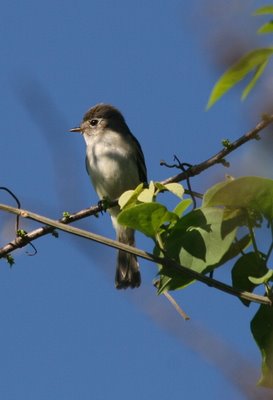 Many of the more cooperative birds in Guatemala were Neotropical migrants, like this least flycatcher. Well, they were cooperative about having their photos taken, but none of them would call for us, so we were left with trusting our instincts and the range maps in the field guide as to their identities. The tapered, elliptical eyering and overall grayness of this little Empid pointed to least flycatcher for me.
Many of the more cooperative birds in Guatemala were Neotropical migrants, like this least flycatcher. Well, they were cooperative about having their photos taken, but none of them would call for us, so we were left with trusting our instincts and the range maps in the field guide as to their identities. The tapered, elliptical eyering and overall grayness of this little Empid pointed to least flycatcher for me.In blogging about Guatemalan birds, remember that I'm limited to writing about the ones for which I got decent pictures. They tend to be the commoner, easier to see birds. No matter: they're fabulous enough for nature-starved folks like you and me. Because I always had the blog in mind, getting pictures of even a fraction of the birds we were spotting became a neurotic quest for me. I came back with gobs of pictures that are no good at all, a few that are at least identifiable, and a tiny handful that are worth looking at twice. The white-winged tanager here is a good example. You can tell what it is, but even with sharpening and cropping, it doesn't come close to doing a terrific little bird justice.
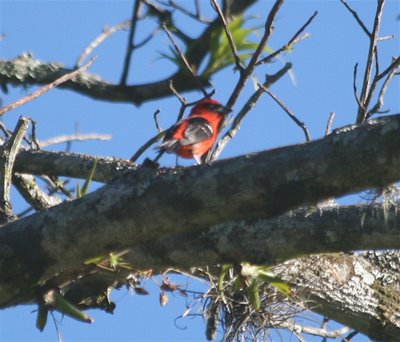 Overall, they're snapshots, just me trying to bring you something to look at, struggling against the nocturnal shadows and blinding sun of the tropical forest. In this modest quest, I felt well-matched to my camera rig, which is a Canon Digital Rebel XTi with 70-300 mm. zoom lens. It's fairly light and easy to carry, and ready to be swung up at a second's notice. I've developed a rudimentary understanding of what I have to do in difficult light conditions (and they all seem to be difficult in deep tropical forest). Picture me madly spinning dials, opening up f-stops and speeding up ISO. It's cool to get at least some souvenir of a memorable sighting. So let the parade of mediocre bird pictures begin!
Overall, they're snapshots, just me trying to bring you something to look at, struggling against the nocturnal shadows and blinding sun of the tropical forest. In this modest quest, I felt well-matched to my camera rig, which is a Canon Digital Rebel XTi with 70-300 mm. zoom lens. It's fairly light and easy to carry, and ready to be swung up at a second's notice. I've developed a rudimentary understanding of what I have to do in difficult light conditions (and they all seem to be difficult in deep tropical forest). Picture me madly spinning dials, opening up f-stops and speeding up ISO. It's cool to get at least some souvenir of a memorable sighting. So let the parade of mediocre bird pictures begin!Chachalacas make more of an aural impression on the landscape than a visual one. Drab brown, with a white vent (this is the white-bellied chachalaca, a nice regional endemic that lots of birders like to tick off their lists in Guatemala), the white-bellied chacha cuts the air with its grating chorus of cha-cha LAC! cha-cha-LAC!, given in groups of five to ten. It's very loud, a classic sound of the tropics. Chachas, as we liked to call them, are related to guans and currasows, and are generally quickly hunted out unless protected, as they are at Los Tarrales.
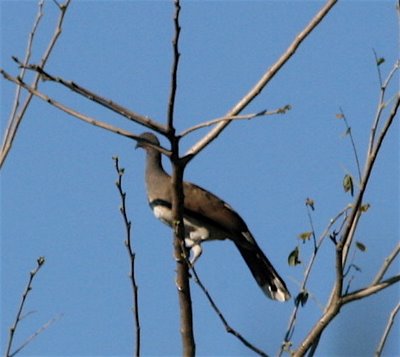 An unfortunate shot, with the branch obscuring his nice red wattle. Oh well, you take what you get, and not all of it is National Geographic caliber. It's a chachalaca. The dark band on the breast is a branch shadow. Here, a chacha sings out the day as the tropical night falls like a cloth. He's the tiny fleck in the left center of the picture.
An unfortunate shot, with the branch obscuring his nice red wattle. Oh well, you take what you get, and not all of it is National Geographic caliber. It's a chachalaca. The dark band on the breast is a branch shadow. Here, a chacha sings out the day as the tropical night falls like a cloth. He's the tiny fleck in the left center of the picture.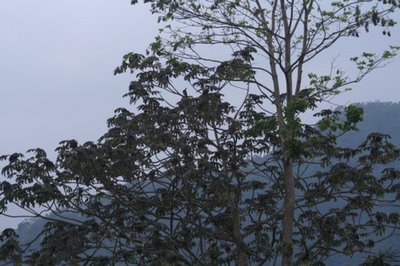 One of the cutest little characters of mid-level tropical forest is the common tody-flycatcher. An Andy Gump chin, long, flat bill, staring white eye and gnatcatcher-like tail characterize him. The best thing he did I couldn't capture in a picture. When it's excited, the common tody-flycatcher raises its long thin tail up over its back and slowly swivels it in a circle, like he's waiting for a pitch. I found myself chanting, "Hey, batter batter Hey batter!" and talking to him as if he were a pet parakeet. He didn't seem to mind. The whole affair is maybe 4" long. Tiny, cute Todirostrum cinereum, we could use some of you up here in the Ohio woods.
One of the cutest little characters of mid-level tropical forest is the common tody-flycatcher. An Andy Gump chin, long, flat bill, staring white eye and gnatcatcher-like tail characterize him. The best thing he did I couldn't capture in a picture. When it's excited, the common tody-flycatcher raises its long thin tail up over its back and slowly swivels it in a circle, like he's waiting for a pitch. I found myself chanting, "Hey, batter batter Hey batter!" and talking to him as if he were a pet parakeet. He didn't seem to mind. The whole affair is maybe 4" long. Tiny, cute Todirostrum cinereum, we could use some of you up here in the Ohio woods.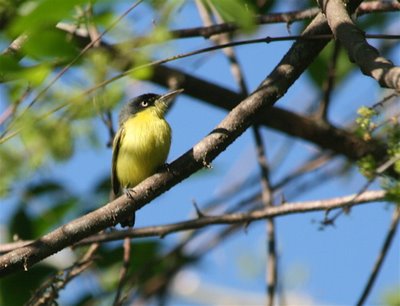
Perhaps the most striking bird to inhabit Los Tarrales is the white-throated magpie jay, Calocitta formosa. Those of you who've done a bit of global birding know that any bird with "magpie" in its name is going to be well-endowed in the gee-whiz department. White-throated magpie jays do not disappoint. I will never forget the first time I laid eyes on one, in the Guanacaste province of Costa Rica. Lee-ord. It was like a giant blue jay that had gotten into the dress-up trunk in the attic. What's that they say about a picture being worth...
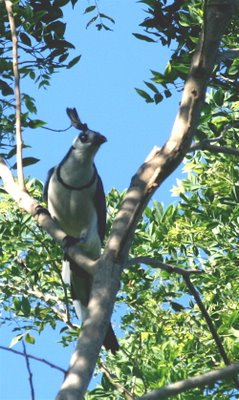 This creature is loud, raucous, tame and inquisitive. It is also 18" long. It's about what you'd get if you scaled a blue jay up by 200% and gave him a good stiff mojito to remove his inhibitions.
This creature is loud, raucous, tame and inquisitive. It is also 18" long. It's about what you'd get if you scaled a blue jay up by 200% and gave him a good stiff mojito to remove his inhibitions.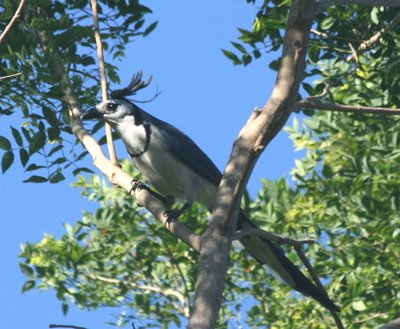
Gotta love the hairdo. Just a little fillip to add to his general impressiveness. In flight, they're unmistakable, always breathtaking.
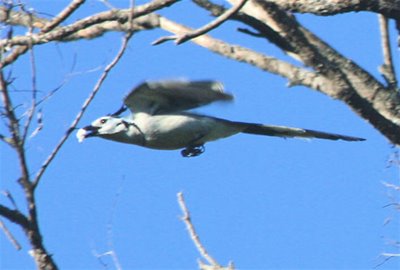 Imagine living in a place where such sights are commonplace; not even giving an 18" long crazy beautiful magpie jay a second glance. We all take for granted that which is common. The jays seemed to enjoy being gasped at by the greenhorns draped in optics.
Imagine living in a place where such sights are commonplace; not even giving an 18" long crazy beautiful magpie jay a second glance. We all take for granted that which is common. The jays seemed to enjoy being gasped at by the greenhorns draped in optics.As I write, the first fox sparrow of spring is feeding on the greening lawn. And the woodcocks sang and danced last evening. Bill raced home to catch the end of their act, and we grilled lamb and asparagus in a welcome-spring, welcome-home celebration.
Labels: Canon Digital Rebel XTi, common tody-flycatcher, fox sparrow, Guatemala birding, Los Tarrales, tropical bird photography, white-bellied chachalaca, white-throated magpie jay, woodcock





